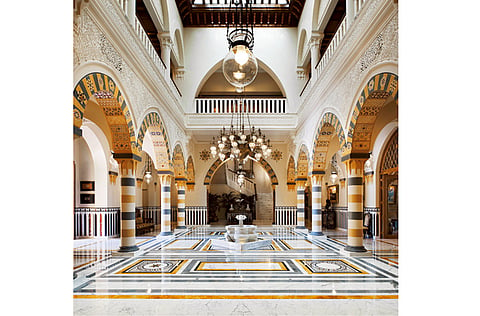A majestic Kuwaiti palace designed by Alberto Pinto
Splendour and high style converge in this striking 21st-century palace

Since the 18th century, merchants from around the world would converge on the port of Kuwait, and pearl divers would trade their lustrous wares for the finest merchandise from all over the globe.
So it is fitting that a 21st-century palace in Kuwait reflects the finest materials and crafts from around the Islamic empire, created by the very best Western artisans. Overseen by master French designer Alberto Pinto, this sprawling regal residence features three separate apartments, one for the master of the house and his wife, and one each for their two children, a son and daughter.
“The inspiration for this palace came from the original and classic idea of orientalism – a traveller taking a long voyage through the Orient,” Pinto explains. “Therefore I took inspiration from as far and wide as a Syrian palace in Aleppo, and a Maharaja’s palace in Rajasthan.”
The journey through the Orient begins in the imposing double-height entrance atrium, typical of the traditional Islamic courtyard home. Its proportions and styling were inspired by a mosque in Cairo, while details under arches are drawn from intricate Syrian crafts, recreated by French artisans.
Doors to other rooms are hewn in wood, with delicate tortoise shell and mother-of-pearl inlays. The adjacent living room takes its guests to Granada with its intricate carved-oak wall panels.
The dining room, which can seat 18 people, conjures up the allure of an Ottoman palace, with its imposing coffered ceilings and marble floor. A delicate tendril motif, created using the finest gold leaf and tiny mirrors, is inspired by the Maharaja’s palace in Rajasthan, and pours over all its walls.
A second, much more intimate dining room features design references from Morocco, with its intricate mirror-backed Mashrabiya screens. The family living quarters are specifically designed to be less formal than the main entertaining spaces on the lower level.
The coral family room features a 1930s-inspired carpet, antique oil lamp-derived chandeliers and ceiling panels designed after a palace on the Bosporus. All these design aspects combine to create a dynamic and fun atmosphere.
The daughter’s bedroom is designed as a 15th-century ceremonial tent. And in the master bedroom and adjacent living room, elements of Alhambra, the Ottoman Empire and even a bedspread designed for Marie Antoinette, unite to create the ultimate luxury, set in cream and delicate sky blue.
These colours offset the azure views of the Gulf, seen through a wrap-around balcony and the oak wall lattices, perfectly. In order to create the
illusion of space in the relatively small bathroom, Pinto created a montage of etched mirrors.
When it came to designing the son’s private apartment, a more contemporary approach was required. He is a true art connoisseur, so his impressive collection was set against a monochrome backdrop of bold black and white, offset with the occasional splash of red.
At the same time, in order to give this sub-project a sense of place and harmony with the rest of the home, Oriental design elements were never far behind. Stuccoed walls are all white and a ceiling motif borrowed from a Turkish palace is set in plain black oak, rather than its original blend of traditional colours. While most of the furniture is contemporary (designed by Carlo Bugatti) and set in materials such as chrome and iron, more traditional pieces occasionally crop up.
Clearly a project of this magnitude with so many intricate details and varied design styles takes a lot of time and talent to create. As Pinto looks back on the life of this project, from research to site supervision, he recalls, “We always learn a lot from our projects, as each is a new adventure, but thankfully when we achieved the required result, after a lot of perseverance, we learnt that being patient pays off. As it happens sometimes, the design we chose for certain areas in this palace needed more time to be developed.”
When asked about his favourite space, he smiles and replies diplomatically. “It is very difficult for us to choose,” he says. “As you can imagine, when you create harmony in a project, all of the rooms become your babies.”
Sign up for the Daily Briefing
Get the latest news and updates straight to your inbox

